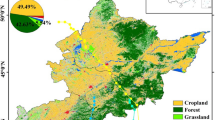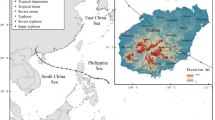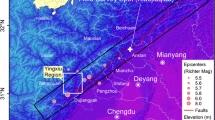Abstract
Remote sensing is a cost-effective tool for assessing vegetation damage by typhoon events at various scales. Taking Xiamen Island, southeastern China, as a study case, this paper aimed to assess and analyze the vegetation damage caused by Typhoon Meranti landfalling on September 15, 2016, using two high spatial resolution remote sensing images before and after the typhoon event. Seven severely damaged vegetation regions were selected based on the classification of vegetation types and visual interpretation of the images. Regression analysis was used to correct seasonal variation of the two high-solution images before and after typhoon. The vegetation area of the whole of Xiamen Island and the selected seven regions before and after typhoon were then calculated, respectively. Two spectral vegetation indicators, normalized difference vegetation index (NDVI) and fractional vegetation coverage (FVC), were also retrieved for the whole island and the seven regions. By comparing the difference in NDVI values before and after the typhoon of the two high spatial resolution images, we analyzed the most affected vegetation areas, as well as the most seriously damaged vegetation species. The typhoon has caused a decrease in vegetation area by 95.1 ha across the whole Xiamen Island. The mean NDVI and FVC decreased by 0.209 and 13 percentage points, respectively. While, in the seven selected severely damaged areas, the mean NDVI decreased by 0.356–0.444 and FVC decreased by 27–42 percentage points. The visual inspection showed that the tone of typhoon-damaged vegetation became darker, the patches of damaged vegetation became smaller and more fragmented, and the gap between vegetation canopies became larger. The most affected vegetation areas occurred in the southeastern hilly area, Jinshang and Hubin South Roads, as well as the Wuyuan Bay area. The most seriously damaged vegetation type is broad-leaved trees, especially the species, Acacia confusa, Delonix regia, Bauhinia variegata, Chorisia speciosa, Ficus benjamina and F. Concinna.







Similar content being viewed by others
References
Ayala-Silva T, Twumasi YA (2004) Hurricane Georges and vegetation change in Puerto Rico using AVHRR satellite data. Int J Remote Sens 25(9):1629–1640
Bao A, Huang Y, Ma Y, Guo H, Wang Y (2017) Assessing the effect of EWDP on vegetation restoration by remote sensing in the lower reaches of Tarim River. Ecol Indic 74:261–275
Bhowmik AK, Cabral P (2013) Cyclone Sidr impacts on the Sundarbans floristic diversity. Earth Sci Res 2(2):62
Bossler JD, Jensen JR, McMaster RB, Rizos C (2002) Manual of geospatial science and technology. Taylor & Francis, London, p 623
Camacho-De Coca F, García-Haro FJ, Gilabert MA, Meliá J (2004) Vegetation cover seasonal changes assessment from TM imagery in a semi-arid landscape. Int J Remote Sens 25(17):3451–3476
Carlson TN, Ripley DA (1997) On the relation between NDVI, fractional vegetation cover, and leaf area index. Remote Sens Environ 62(3):241–252
Chander G, Coan MJ, Scaramuzza PL (2008) Evaluation and comparison of the IRS-P6 and the Landsat sensors. IEEE Trans Geosci Remote 46(1):209–221
Chander G, Markham BL, Helder DL (2009) Summary of current radiometric calibration coefficients for Landsat MSS, TM, ETM + , and EO-1 ALI sensors. Remote Sens Environ 113(5):893–903
Chavez PS Jr (1996) Image-based atmospheric corrections-Revisited and revised. Photogramm Eng Rem S 62(9):1025–1036
Chen CF, Son NT, Chen CR, Cho K, Hsiao YY, Chiang SH, Chang LY (2015) Assessing rice crop damage and restoration using remote sensing in tsunami-affected areas. Jpn J Appl Remote Sens 9(1):096002
China Meteorological Administration (2016) Typhoon Morandi hit Xiamen, Fujian at 3:05 am on 15 September 2016 and affected parts of Fujian, Zhejiang and Jiangsu (in Chinese). http://www.cma.gov.cn/2011xwzx/2011xqxxw/2011xqxyw/201609/t20160915_322527.html. 2 Nov 2016
China Resources Satellite Application Center (2016) Absolute radiometric calibration coefficient of Chinese earth observation satellite in 2016 (GF-2, GF-1, GF-4, ZY-3, ZY-1 02C, CBERS-04, SJ-9A, HJ-1A/B). http://www.cresda.com/CN/Downloads/dbcs/10506.shtml. 2 Nov 2016
Chu T, Guo X, Takeda K (2016) Remote sensing approach to detect post-fire vegetation regrowth in Siberian boreal larch forest. Ecol Indic 62:32–46
Clemente RH, Cerrillo RMN, Gitas IZ (2009) Monitoring post-fire regeneration in Mediterranean ecosystems by employing multitemporal satellite imagery. Int J Wildland Fire 18(6):648–658
Cristiano PM, Madanes N, Campanello PI, Francescantonio DD, Rodriguez SA, Zhang YJ, Carrasco LO, Goldstein G (2014) High NDVI and potential canopy photosynthesis of south american subtropical forests despite seasonal changes in leaf area index and air temperature. Forests 5(2):287–308
Elsner JB, Kossin JP, Jagger TH (2008) The increasing intensity of the strongest tropical cyclones. Nature 455(7209):92–95
Ganguly S, Schull MA, Samanta A, Shabanov NV, Milesi C, Nemani RR, Knyazikhin Y, Myneni RB (2008) Generating vegetation leaf area index earth system data record from multiple sensors. Remote Sens Environ 112(12):4333–4343
Guo XY, Zhang HY, Wang YQ, Clark J (2015) Mapping and assessing typhoon-induced forest disturbance in Changbai Mountain National Nature Reserve using time series Landsat imagery. J Mt Sci Engl 12(2):404–416
Gutman G, Ignatov A (1998) The derivation of the green vegetation fraction from NOAA/AVHRR data for use in numerical weather prediction models. Int J Remote Sens 19(8):1533–1543
Hoque MAA, Phinn S, Roelfsema C, Childs I (2016) Assessing tropical cyclone impacts using object-based moderate spatial resolution image analysis: a case study in Bangladesh. Int J Remote Sens 37(22):5320–5343
Jangir B, Satyanarayana ANV, Swati S, Jayaram C, Chowdary VM, Dadhwal VK (2016) Delineation of spatio-temporal changes of shoreline and geomorphological features of Odisha coast of India using remote sensing and GIS techniques. Nat Hazards 82(3):1437–1455
Jensen JR (2005) Introductory digital image processing: a remote sensing perspective. Prentice-Hall Inc, Upper Saddle river
Jiang Z, Huete AR, Chen J, Chen Y, Li J, Yan G, Zhang X (2006) Analysis of NDVI and scaled difference vegetation index retrievals of vegetation fraction. Remote Sens Environ 101(3):366–378
Jing X, Yao WQ, Wang JH, Song XY (2011) A study on the relationship between dynamic change of vegetation coverage and precipitation in Beijing’s mountainous areas during the last 20 years. Math Comput Model 54(3–4):1079–1085
Jing Y, Li J, Weng Y, Wang J (2014) The assessment of drought relief by typhoon Saomai based on MODIS remote sensing data in Shanghai, China. Nat Hazards 71(2):1215–1225
Kavzoglu T, Colkesen I (2009) A kernel functions analysis for support vector machines for land cover classification. Int J Appl Earth Obs 11:352–359
Klemas VV (2009) The role of remote sensing in predicting and determining coastal storm impacts. J Coastal Res 25(6):1264–1275
Li K, Li GS (2013) Risk assessment on storm surges in the coastal area of Guangdong Province. Nat Hazards 68(2):1129–1139
Linden SVD, Janz A, Waske B, Eiden M, Hostert P (2007) Classifying segmented hyperspectral data from a heterogeneous urban environment using support vector machines. J Appl Remote Sens 1(1):341–353
Long J, Giri C, Primavera J, Trivedi M (2016) Damage and recovery assessment of the Philippines’ mangroves following Super Typhoon Haiyan. Mar Pollut Bull 109(2):734–743
Lugo AE (2008) Visible and invisible effects of hurricanes on forest ecosystems: an international review. Austral Ecol 33(4):368–398
Macamo CCF, Massuanganhe E, Nicolau DK, Bandeira SO, Adams JB (2016) Mangrove’s response to cyclone Eline (2000): what is happening 14 years later. Aquat Bot 134:10–17
Mountrakis G, Im J, Ogole C (2011) Support vector machines in remote sensing: a review. ISPRS J Photogramm 66:247–259
Muster S, Langer M, Abnizova A, Young KL, Boike J (2015) Spatio-temporal sensitivity of MODIS land surface temperature anomalies indicates high potential for large-scale land cover change detection in Arctic permafrost landscapes. Remote Sens Environ 168:1–12
Saunier S, Goryl P, Chander G, Santer R, Bouvet M, Collet B, Mambimba A, Aksakal SK (2010) Radiometric, geometric, and image quality assessment of ALOS AVNIR-2 and PRISM sensors. IEEE Trans Geosci Remote 48(10):3855–3866
Schneider A (2012) Monitoring land cover change in urban and peri-urban areas using dense time stacks of Landsat satellite data and a data mining approach. Remote Sens Environ 124:689–704
Stoy PC, Quaife T (2015) Probabilistic downscaling of remote sensing data with applications for multi-scale biogeochemical flux modeling. PLoS ONE 10(6):e0128935
Tigges J, Lakes T, Hostert P (2013) Urban vegetation classification: benefits of multitemporal RapidEye satellite data. Remote Sens Environ 136(5):66–75
Tortini R, van Manen SM, Parkes BRB, Carn SA (2017) The impact of persistent volcanic degassing on vegetation: a case study at Turrialba volcano, Costa Rica. Int J Appl Earth Obs 59:92–103
USGS (2016) Landsat 8 Data. http://landsat.usgs.gov/landsat-8 (L8) data users handbook. php. 2 Nov 2016
Verbesselt J, Hyndman R, Newnham G, Culvenor D (2010) Detecting trend and seasonal changes in satellite image time series. Remote Sens Environ 114(1):106–115
Webster PJ, Holland GJ, Curry JA, Chang HR (2005) Changes in tropical cyclone number, duration, and intensity in a warming environment. Science 309(5742):1844–1846
Wu C, Gonsamo A, Gough CM, Chen JM, Xu S (2014) Modeling growing season phenology in North American forests using seasonal mean vegetation indices from MODIS. Remote Sens Environ 147(18):79–88
Xu HQ, He H, Huang SL (2013) Analysis of fractional vegetation cover change and its impact on thermal environment in the Hetian basinal area of County Changting, Fujian province, China (in Chinese). Acta Ecol Sin 33(10):2954–2963
Yang C, Ren X, Huang H (2012) The vegetation damage assessment of the Wenchuan earthquake of May 2008 using remote sensing and GIS. Nat Hazards 62(1):45–55
Yu L, Liu T, Bu K, Yang J, Zhang S (2017) Monitoring forest disturbance in Lesser Khingan Mountains using MODIS and landsat TM time series from 2000 to 2011. J Indian Soc Remote 45(5):837–845
Zhang Y (2002) A new automatic approach for effectively fusing Landsat 7 as well as IKONOS images. In: Geoscience and remote sensing symposium, pp 2429–2431
Zhang X, Wang Y, Jiang H, Wang X (2013) Remote-sensing assessment of forest damage by Typhoon Saomai and its related factors at landscape scale. Int J Remote Sens 34(21):7874–7886
Acknowledgments
This study was supported by the National Key Research and Development Project (Grant Number: 2016YFA0600302) and the National Natural Science Foundation of China [Grant Number: 41501469, 2015]. The authors are also grateful to the four referees for their constructive comments on the manuscript.
Author information
Authors and Affiliations
Corresponding author
Rights and permissions
About this article
Cite this article
Wang, M., Xu, H. Remote sensing-based assessment of vegetation damage by a strong typhoon (Meranti) in Xiamen Island, China. Nat Hazards 93, 1231–1249 (2018). https://doi.org/10.1007/s11069-018-3351-7
Received:
Accepted:
Published:
Issue Date:
DOI: https://doi.org/10.1007/s11069-018-3351-7




